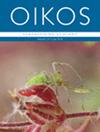幸存巨型动物在种子远距离传播中不可替代的作用:来自新热带哺乳动物实验的证据
IF 3
2区 环境科学与生态学
Q2 ECOLOGY
引用次数: 0
摘要
选择性失活导致散播者群体规模缩小是一种世界性现象,被认为会对动物散播的植物产生重要影响。许多大种子的新热带植物目前依赖于最后的巨型动物幸存者--大型貘(Tapirus spp.)和中型食草动物。中型食俭动物在多大程度上与貘具有同等功能仍是一个未知数。我们结合喂食试验、基于种子滞留时间和动物运动模拟(利维行走)的种子扩散核模型,以及大种子棕榈树的发芽实验,从扩散距离和肠道通过对发芽的影响两方面评估了最大(貘)和两种中等(狐狸和吼猴)食俭动物的扩散质量。貘在肠道中保留种子的时间(平均 = 221 小时)远远长于吼猴(43 小时)和狐狸(22 小时)。貘的中位传播距离(1252 米)分别是狐(88 米)和驯鹿(31 米)的 14 倍和 40 倍。貘的种子扩散内核显示的第 5 百分位数(291 米)大于狐狸(285 米)和嚎鹿(108 米)的第 95 百分位数。人工剥离和肠道传递的种子发芽比例相似,分别是完整果实的 3.5 倍和 2.5-2.9 倍。种子的发芽率和存活率随着在嚎貘和貘肠道中停留时间的延长而降低,其中嚎貘的负相关关系更为明显。这种不利影响意味着发芽成功率和传播距离之间存在权衡。我们的结论是,貘在提高萌发率方面可能并不扮演独特的角色,但它比中等食草动物能将种子传播得更远,因此在许多植物的远距离传播中扮演着重要角色。这项研究提供了关于棕榈-食草动物相互作用的重要见解,以及失去新热带地区最后的巨型动物代表对大种子植物的潜在后果。本文章由计算机程序翻译,如有差异,请以英文原文为准。
The irreplaceable role of surviving megafauna in long‐distance seed dispersal: evidence from an experiment with Neotropical mammals
The downsizing of disperser assemblages by selective defaunation is a worldwide phenomenon thought to have important consequences in animal‐dispersed plants. Numerous large‐seeded Neotropical plants currently depend on the last megafaunal survivors, the large tapirs Tapirus spp., and medium‐sized frugivores. The extent to which medium frugivores are functionally equivalent to tapirs remains unresolved. We combined feeding trials, seed dispersal kernel modeling based on seed retention times and animal movement simulation (Levy walks), and germination experiments in a large‐seeded palm to assess the dispersal quality provided by the largest (tapirs) and two medium (foxes and howler monkeys) frugivore species in terms of dispersal distances and gut passage effects on germination. Tapirs retained the seeds in the gut for much longer (mean = 221 hours) than howlers (43 h) and foxes (22 h). Median dispersal distance by tapirs (1252 m) was 14 and 40 times larger than that by foxes (88 m) and howlers (31 m), respectively. The seed dispersal kernel of tapirs showed a 5th percentile value (291 m) larger than the 95th percentiles of foxes (285 m) and howlers (108 m). Manually depulped and gut‐passed seeds germinated in similar proportions, showing, respectively, 3.5 and 2.5–2.9 times higher values than intact fruits. Germination probability and seed viability decreased with retention time in howlers' and tapirs' gut, with howlers showing a steeper negative relationship. Such detrimental effect implies a trade‐off between germination success and dispersal distance. We conclude that tapirs may not play a unique role in germination enhancement but move seeds much further than medium frugivores, thus playing a critical role as long‐distance dispersers of many plants. This study provides important insights on palm–frugivore interactions and the potential consequences for large‐seeded plants of losing the last megafaunal representatives in the Neotropics.
求助全文
通过发布文献求助,成功后即可免费获取论文全文。
去求助
来源期刊

Oikos
环境科学-生态学
CiteScore
6.20
自引率
5.90%
发文量
152
审稿时长
6-12 weeks
期刊介绍:
Oikos publishes original and innovative research on all aspects of ecology, defined as organism-environment interactions at various spatiotemporal scales, so including macroecology and evolutionary ecology. Emphasis is on theoretical and empirical work aimed at generalization and synthesis across taxa, systems and ecological disciplines. Papers can contribute to new developments in ecology by reporting novel theory or critical empirical results, and "synthesis" can include developing new theory, tests of general hypotheses, or bringing together established or emerging areas of ecology. Confirming or extending the established literature, by for example showing results that are novel for a new taxon, or purely applied research, is given low priority.
 求助内容:
求助内容: 应助结果提醒方式:
应助结果提醒方式:


